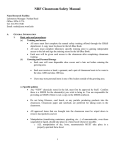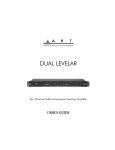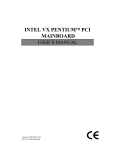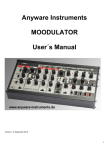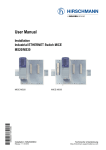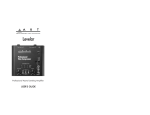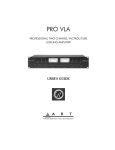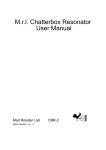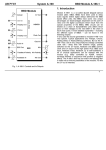Download DOEPFER System A-100 X-treme Filter A-106
Transcript
DOEPFER System A-100 X-treme Filter A-106-1 1. Introduction Fig. 1: A-106-1 Controls and In/Outputs Module A-106-1 is an unique low/high pass filter and has it's origin in our experiments to built a MS20 filter clone. In contrast to other filter designs it has different audio inputs for low and high pass, but only one audio output. The type of filter (12dB low pass, 6dB high pass or any mix) is defined by the shares of the audio signal fed to the corresponding inputs. Even two different audio signals can be used as low and high pass input. A special feature is the polarizer at the high pass input that allows to add/subtract the high pass to/from the low pass share, leading to pseudo band pass and notch responses (details concerning pseudo in the next chapter). Another special feature are the clipping controls, which allow independent adjustment of the positive and negative clipping level. The resonance goes up to self-oscillation, but with a clearly different behaviour than on other filters. At certain resonance and clipping settings the self-oscillation generates rectangle or short sawtooth shaped pulses. In general the A-106-1 is a very strange and awesome filter and far away from being perfect (e.g non-linear control scale, self-oscillation with all sorts of waveforms except sine, a lot of roaring, rattling, noise or other unpredictable sounds at high distortion and resonance settings, high distortion or audio level overrides the resonance, significant CV feedthrough …). But the A-106-1 has a lot of character – probably much more than any other filter of the A-100 – and is able to generate filter sweeps which are not possible with any other filter. 1 X-treme Filter A-106-1 System A-100 2. Basic Principles As mentioned in the introduction, module A-106-1 has it's origin in our experiments to built a MS20 filter clone. The famous original MS20 included two filters: a 12 dB low pass and a 6dB high pass filter connected in series, both with a very special design. Remark: The MS20 high pass if very often described as 12dB high pass, but this is not true. During our research we found a way to use the same circuit simultaneously as low pass and high pass for 2 different audio signals (a bit similar to the A-101-1 Steiner Vactrol filter, which also has different audio inputs available, but with the special MS20 circuit). For this two separate audio inputs for low pass (LP) and high pass (HP) with separate level controls are available. The sockets are normalled, i.e. the signal applied to the LP input is available for the HP input too, provided that no plug is inserted into the HP input socket. The level control of the HP input is realized as a polarizer. This means that the signal can be added with the same polarity (+ range) or opposite polarity (- range) compared to the LP input. This feature enables pseudo notch (+) and pseudo band pass (-) filter functions too. From our point of view this is the most flexible solution as it enables these functions: 2 • • • DOEPFER Low pass: the audio signal is fed to the LP input, HP level control is set to zero, LP level control is set to the desired level High pass: the audio signal is fed to the LP or HP input, LP level control is set to zero, HP level control is set to the desired level (in this special case it does not matter if positive or negative amplification is chosen with the polarizer control) Low pass / high pass mix with one audio signal: the audio signal is fed to the LP input, LP and HP level controls are set to the desired levels. o special setting 1: if the level controls for LP and HP are set in a way that both levels are identical with the same polarity (i.e. + range of the HP level control) and no or little distortion only one obtains a pseudo notch filter (pseudo means that the notch is far away from being perfect, the attenuation in the pass band is not as good as for other filters of the A-100 system, please refer to the frequency response curves for details) o special setting 2: if the level controls for LP and HP are set in a way that both levels are identical with the opposite polarity (i.e. - range of the HP level control) and no or little distortion only, one obtains a pseudo band pass filter (pseudo means that even the band pass is far away from being perfect, there is a significant feedthrough of frequencies below and above the center frequency, please refer to the frequency response curves for details) DOEPFER o System A-100 Remark for settings 1 and 2: The original MS20 circuit was not planned for notch or band pass applications. The pseudo notch and pseudo band pass filters should be treated as a free bonus and have the disadvantages mentioned above. The reason is that the low pass has a 12dB/octave slope and the high pass has 6dB/octave. This leads to phase relations that do not allow a "perfect" band pass and notch simply by adding/subtracting signals as for other filter designs (for insiders: there remains always a 90 degree phase shift). For better notches and band passes other A-100 filters should be used - or two A-106-1 patched in series (band pass) or parallel (notch) with suitable frequency settings. • X-treme Filter A-106-1 Low pass and high pass with two different audio signals: the two audio signals are fed to the LP input resp. HP input and the level controls for LP and HP are set to the desired levels. For the +/- control of the HP input it is essential in this case if the two input signals are phase correlated (e.g. two different outputs of the same VCO or VCO output and a frequency divided signal derived from this VCO) or if there is no fixed phase correlation between the two signals (e.g. two different VCOs). In the first case the - and + range of the HP control leads to different filter results. In the second case there is no difference, if the + or - range of the HP control is used. This design allows even some very special functions: It is e.g. possible to adjust the controls so that the LP signal does not distort, but the HP share does (or the other way round) - alternatively with the same or opposite polarity compared to the LP signal. For this the LP level has to be set to a small value so that the signal does not distort. The HP level control has to be set to a higher value (in the + or range) so that the HP share will distort. The variety of controls allows a lot of functions which are not available for any other filter we know. 3 X-treme Filter A-106-1 System A-100 Low pass (no resonance) High pass (no resonance) Pseudo Band pass (no resonance) Pseudo Notch (no resonance) Low pass (medium resonance) High pass (high resonance) Fig. 2: A-106-1 Frequency Response Curves 4 DOEPFER DOEPFER System A-100 During the A-106-1 development we found also that it might be useful to add controls not available on the original MS20 filters. In the original circuit the filter output level is limited to about +/– 0.7V by two antiparallel diodes across the output/resonance amplifier. Removing one or both diodes leads to noticeable different behaviour of the filter. We added two rotary controls CL+ and CL- to adjust the effect of each limiting diode (i.e. from original MS20 behaviour with fully active limiting diodes to no limiting effect). The independent control for each diode allows asymmetrical limiting/amplification that causes a completely new and sometimes very strange behaviour. X-treme Filter A-106-1 One of the main effects of the asymmetrical limiting is that in self-oscillation the filter does not generate a sine wave but short pulses, if only one of the limiting diodes is activated. Another effect is that a higher output level of the filter can be obtained (which is limited to about +/- 0.7V for the original MS20 circuit). In addition dirty noise effects appear at certain combinations of the control settings for resonance, CL+, CL- and input level. The controls CL+, CL-, resonance, LP level and HP level have to be treated in a common context: if the input levels are small the CL+ and CLcontrols will have no effect as the signal does not distort at all because it does not reach the clipping levels. Increasing the resonance also increases the audio level and the CL+/CL- controls may now have an effect on the output level without changing the input level ! Same applies if the resonance control remains unchanged while the input level increases. Now the CL+ or CL- control will have an effect as the level reaches the clipping thresholds. Increasing the audio level may also suppress the resonance if distortion becomes extreme. The "teamwork" of the five controls is very complex and has to be learned by doing and hearing. Fig. 3 : A-106-1 Clipping functions The audio inputs are very sensitive to allow even extreme distortion effects, much more than possible for the original MS20. The module is equipped with an insert option for the resonance feedback loop. This allows to insert other A-100 5 X-treme Filter A-106-1 System A-100 modules into the resonance circuit. The standard application is to insert a VCA for voltage controlled resonance. But even other modules - e.g. waveshaper, divider, phaser, distortion, PLL, wave multiplier, spring reverb, ring modulator, frequency shifter, BBD or any other audio processing module - can be inserted to obtain sounds one has probably never heard before. On top of this the module is equipped with three frequency control voltage inputs (CV). One CV input is equipped with a polarizer. This means that the effect of the external CV (e.g. envelope from an ADSR generator) to the filter frequency is positive (+ range) or negative (- range). Especially when the filter is moved from LP to HP it might be useful to invert the polarity of the envelope CV. It has to be pointed out that the frequency response is far away from being 1V/oct but rather non-linear. Pay attention that the CV3 and high pass level controls are polarizers with zero level at the center position. Especially for the high pass control it is a bit tricky to find the neutral position. Here are two solutions for this problem: • 6 Insert an unconnected patch cable or a single 3,5 mm jack plug into the high pass input (the two terminals of the plug may even be shortened). For this reason a 30 cm patch cable is added to each A-106-1 module for free. You may even nip off the jack plug of the cable to have it available especially for this function. • DOEPFER Change the high pass polarizer into a normal attenuator by moving the jumper JP4 to the lower position (see below) Pay attention that for pure low pass function of the module the high pass control "HP level" has to be in the neutral position or even better a dummy plug is inserted into the high pass input "HP In". To obtain the filter section of the original MS20 two A-106-1 have to be patched in series (one in LP mode, the other in HP mode, both with CL+ and CL- set to zero). The A-106-1 is far away from being a "perfect" filter in an academic sense. The control scale is non-linear. With selfoscillation all sorts of waveforms except sine are generated. High distortion and resonance settings lead to roaring, rattling, noise or other unpredictable sounds. High distortion or audio level may "kill" the resonance at certain settings. The filter has a significant control voltage feedthrough. The "band pass" is not a real band pass as a considerable share of all frequencies passes through. The notch filter does attenuate only about 50% at the center frequency - and many more specialties. But the A-106-1 has a lot of character - much more than any other filter of the A-100. It is a very strange and awesome filter - somehow quite the opposite of the 48 dB ladder filter A-108, which is a very smooth, warm and predictable filter. The A-106-1 is definitely not the right choice for "moogish" or "civilized" sounds but for extreme, exceptional and experimental sounds - this is why we call the module "X-filter", also to DOEPFER System A-100 avoid troubles with the Korg company who is the owner of the term "MS20". If you want to know more technical details please look at the document “A-101-1 technical details” on our website www.doepfer.com (available from the A-101-1 or A-106-1 info page). In this document the basics of the A101-1 (Steiner) and A-106-1 ((Xtreme) filters are described. There are two jumpers on the module. • • The first jumper is located on the main board A (the right one with the CL+/CL-/Res. controls) and labelled JP7A/B. In the upper position A (factory setting) the output is unbuffered and has a noticeable DC offset (DC coupled). Unbuffered means that the output load affects the filter behaviour. In the lower position B the output is buffered and has no DC offset (AC coupled). If unexpected behaviour of the A-106-1 output appears try the lower position (buffered mode). The second jumper is located on board B (the left one with the frequency and audio input controls) and labelled JP4. It is a bit difficult to find as it is located behind the 10 pin connector that is used to connect the two boards. It is recommended to remove the female 10 pin connector to change the setting of this jumper. In the upper position (factory setting) the high pass control "HP Lev" works as a polarizer (zero = center position). In the lower position it works as a normal attenuator with zero at the fully counterclockwise position. If you do not want to use the polarizer function (i.e. add/subtract the LP and HP signals) it is recommended X-treme Filter A-106-1 to move the jumper to the lower position. But in this case the (-)/(+) front panel printing for the HP level control is no longer valid. Clipping control option: The module is prepared to control the CL+ and CLparameters by using the universal vactrol module A-101-9. Two pin headers (JP5, JP6, located behind the CL+ control) are used to establish a connection to the universal vactrol module A-101-9. This allows voltage control of CL+ and CL. Please refer to the manual of module A-101-9 for details. 7 X-treme Filter A-106-1 System A-100 DOEPFER 3. Overview ! 1 6 " 2 7 § 3 8 & $ 4 / % ( 5 6 CL+: 7 CL–: 8 Res.: In- / Outputs: ! CV1: " CV2: § CV3: $ LP In: % HP In: & Res. Insert: / Res. Insert: ( Out: manual frequency control attenuator for CV2 polarizer for CV3 low pass audio input attenuator high pass audio input polarizer/ attenuator (*) positive clipping control negative clipping control resonance level control CV1 input (without attenuator/polarizer) CV2 input (with attenuator) CV3 input (with polarizer/attenuator) (*) low pass audio input high pass audio input (normalled to low pass audio input $) resonance insert (output) resonance insert (input) audio output (*) function depends upon jumper settings Fig. 4: front panel 8 Controls: 1 Frequ. : 2 CV2: 3 CV3: 4 LP Level: 5 HP Level: Width: 14HP Current: 30 mA System A-100 DOEPFER X-treme Filter A-106-1 4. Controls and In- / Outputs ! 1 " 2 § 3 CV1: Frequ. : CV2: CV2: CV3: CV3: CV1 input manual frequency control CV2 input attenuator for CV2 CV3 input polarizer/attenuator for CV3 This group of elements is responsible for the filter frequency. Knob 1 Frequ. is used to adjust the frequency manually. Three CV inputs (CV1 !, CV2 ", CV3 §) are available to control the frequency by external control voltages (e.g. ADSR, LFO, random, sequencer). The sensitivity of CV1 is fixed, CV2 is equipped with a normal attenuator 2, CV3 with a polarizer 3. The neutral position of the polarizer knob is at it’s center (0). Left from the center (area marked with a minus sign) the effect of the CV3 is negative, i.e. an increasing CV3 decreases the frequency. Right from the center (area marked with a plus sign) it’s positive, i.e. increasing CV3 increases the frequency. The control scales of the three CV inputs are non-linear, i.e. not 1V/octave as CV inputs of many other A-100 modules. $ LP In: 4 LP Level: % HP In: 5 HP Level: low pass audio input low pass audio input attenuator high pass audio input high pass audio input polarizer/ attenuator Socket $ is the low pass audio input (LP In) with the assigned attenuator 4. Socket % is the high pass audio input (HP In) with the assigned polarizer 5. This polarizer can be converted into a normal attenuator by changing an internal jumper (please refer to page 7 for details). The HP In % is normalled to the LP In $, i.e. if no plug is inserted into the HP In % the signal applied to the LP In $ is also used for the high pass section. For pure LP function the HP Level 5 has to be set approximately to it's center position. The best way to find the neutral positon of the HP control is by hearing. Move the control until the high pass share disappears in the audio output signal. As it is a bit tricky to find the neutral position even a dummy plug can be inserted into the HP In socket for pure LP applications. In this case the normalling between the sockets LP In and HP In is interrupted. Both the LP and the HP audio input are very sensitive. With standard A-100 signals (e.g. VCO) distortion appears already at medium settings. But the distortion also depends upon the clipping and resonance settings. 9 X-treme Filter A-106-1 6 CL+: 7 CL–: System A-100 positive clipping control negative clipping control This controls are used to adjust the upper and lower clipping levels of the filter circuit. At the left position the smallest clipping level is chosen, i.e. clipping appears even at small input levels. Turning a clipping control clockwise increases the clipping level and clipping occurs just at higher levels. The adjustment of the clipping controls also affects the max. output level as for higher clipping levels even the max. output level becomes higher. The module is prepared to control the clipping functions with voltages by using the universal vactrol module A-101-9. For details please refer to page 7 and the A-101-9 user's manual. & Res. Insert: / Res. Insert: 8 Res.: resonance insert (output) resonance insert (input) resonance level control This group of elements is responsible for the resonance functions of the module. Socket / is the input of the resonance loop and is normalled to resonance output socket &. If an external module is used to control the resonance loop (e.g. a VCA), this module has to be inserted between socket & and socket /. The resonance control 8 is used to adjust the resonance level manually. Resonance can be increased up to self-oscillation. As already mentioned in chapter 2 the controls for level, resonance and clipping 10 DOEPFER influence each other. E.g. the waveform generated in selfoscillation mode depends upon the settings of the clipping controls and the resonance, or self-oscillation is reduced or even "killed" by an excessive audio level. ( Out: audio output This socket is the audio output of the module. DOEPFER System A-100 X-treme Filter A-106-1 5. User Examples Voltage Controlled Morphing between LP and HP Voltage Controlled Resonance A voltage controlled panning module A-134 is used to control the shares of the audio signal fed into the LP and HP inputs of the A-106-1. With an external voltage (Morph. CV) the relation between LP and HP is adjusted (e.g. LFO, ADSR, sequencer, random or S&H, Theremin). The resonance insert is processed by a VCA A-130 to obtain voltage controlled feedback. Instead of a VCA even other signal processing modules can be used (e.g. BBD, VC polarizer, waveshaper/wave multiplier, spring reverb, PLL) for special effects. On our web site www.doepfer.com several A-106-1 sound examples are available. 11 X-treme Filter A-106-1 12 System A-100 DOEPFER













